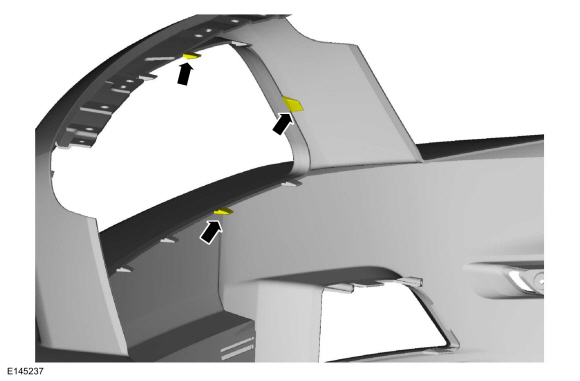Lincoln Corsair: Engine Cooling - 2.0L EcoBoost (177kW/240PS) – MI4 / Diagnosis and Testing - Engine Temperature
Diagnostic Trouble Code (DTC) Chart
Diagnostics in this manual assume a certain skill level and knowledge of Ford-specific diagnostic practices.
REFER to: Diagnostic Methods (100-00 General Information, Description and Operation).
| Module | DTC | Description | Action |
|---|---|---|---|
| PCM | P0116:00 | Engine Coolant Temperature Sensor 1 Circuit Range/Performance: No Sub Type Information | GO to Pinpoint Test DX |
| PCM | P0117:00 | Engine Coolant Temperature Sensor 1 Circuit Low: No Sub Type Information | GO to Pinpoint Test DX |
| PCM | P0118:00 | Engine Coolant Temperature Sensor 1 Circuit High: No Sub Type Information | GO to Pinpoint Test DX |
| PCM | P0119:00 | Engine Coolant Temperature Sensor 1 Circuit Intermittent/Erratic: No Sub Type Information | GO to Pinpoint Test DX |
| PCM | P011E:00 | Engine Coolant Temperature 1 / Ambient Air Temperature Correlation: No Sub Type Information | GO to Pinpoint Test DX |
| PCM | P017C:00 | Cylinder Head Temperature Sensor 'A' Circuit Low: No Sub Type Information | GO to Pinpoint Test DL |
| PCM | P017D:00 | Cylinder Head Temperature Sensor 'A' Circuit High: No Sub Type Information | GO to Pinpoint Test DL |
| PCM | P017E:00 | Cylinder Head Temperature Sensor 'A' Circuit Intermittent/Erratic: No Sub Type Information | GO to Pinpoint Test DL |
| PCM | P101F:00 | Cylinder Head Temperature Sensor 1 Out Of Self Test Range: No Sub Type Information | GO to Pinpoint Test DL |
| PCM | P1021:00 | Cylinder Head Temperature Sensor 2 Circuit Range/Performance: No Sub Type Information | GO to Pinpoint Test DL |
| PCM | P1022:00 | Cylinder Head Temperature Sensor 2 Circuit Low: No Sub Type Information | GO to Pinpoint Test DL |
| PCM | P1023:00 | Cylinder Head Temperature Sensor 2 Circuit High: No Sub Type Information | GO to Pinpoint Test DL |
| PCM | P1024:00 | Cylinder Head Temperature Sensor 2 Circuit Intermittent/Erratic: No Sub Type Information | GO to Pinpoint Test DL |
| PCM | P1025:00 | Cylinder Head Temperature Sensor 2 Out Of Self Test Range: No Sub Type Information | GO to Pinpoint Test DL |
| PCM | P1026:00 | Engine Coolant Temperature 1 / Cylinder Head Temperature 2 Correlation: No Sub Type Information | GO to Pinpoint Test DL |
| PCM | P1116:00 | Engine Coolant Temperature Sensor Out Of Self Test Range: No Sub Type Information | GO to Pinpoint Test DX |
| PCM | P1117:00 | Engine Coolant Temperature Sensor Circuit Intermittent: No Sub Type Information | GO to Pinpoint Test DX |
| PCM | P111B:00 | Engine Coolant Warm-up Not Detected: No Sub Type Information | GO to Pinpoint Test DX |
| PCM | P1285:00 | Cylinder Head Overtemperature Condition: No Sub Type Information | GO to Pinpoint Test DL |
| PCM | P1288:00 | Cylinder Head Temperature Sensor Out Of Self Test Range: No Sub Type Information | GO to Pinpoint Test DL |
| PCM | P1289:00 | Cylinder Head Temperature Sensor Circuit High: No Sub Type Information | GO to Pinpoint Test DL |
| PCM | P128A:00 | Cylinder Head Temperature Sensor Circuit Intermittent/Erratic: No Sub Type Information | GO to Pinpoint Test DL |
| PCM | P1290:00 | Cylinder Head Temperature Sensor Circuit Low: No Sub Type Information | GO to Pinpoint Test DL |
Global Customer Symptom Code (GCSC) Chart
Diagnostics in this manual assume a certain skill level and knowledge of Ford-specific diagnostic practices.
REFER to: Diagnostic Methods (100-00 General Information, Description and Operation).
| Symptom | Action |
|---|---|
| Start/Run/Move > Running > Smoke From Exhaust > Black | GO to Pinpoint Test DL |
| Driving Performance > Idle Quality > Fast > Always | GO to Pinpoint Test DX |
| Driving Performance > Idle Quality > Slow Return > Always | GO to Pinpoint Test DX |
| Driving Performance > Idle Quality > Rough > Always | GO to Pinpoint Test DL |
| Driving Performance > Poor Fuel Economy > Combined > Loaded | GO to Pinpoint Test DL |
Pinpoint Tests
 PINPOINT TEST DL: CYLINDER HEAD TEMPERATURE (CHT) SENSOR
PINPOINT TEST DL: CYLINDER HEAD TEMPERATURE (CHT) SENSOR
 Introduction Introduction
NOTE: On a typical vehicle, the CHT sensor is located in the cylinder head and the CHT 2 sensor is located in the exhaust manifold. Normal Operation and Fault Conditions On applications that do not use an ECT sensor, the CHT sensor is used to determine the engine coolant temperature. To cover the entire temperature range of both the CHT and ECT sensors, the PCM has a dual switching resistor circuit on the CHT input. A graph showing the temperature switching from the COLD END line to the HOT END line, with increasing temperature and back with decreasing temperature is included. Note the temperature to voltage overlap zone. Within this zone it is possible to have either a COLD END or HOT END value at the same temperature. For example, at 90C (194F) the voltage could read either 0.60 volt or 3.71 volts. Refer to the table for the expected values. Voltage values calculated for VREF = 5 volts. These values can vary by 15% due to sensor and VREF variations. Refer to the DTC Fault Trigger Conditions. DTC Fault Trigger Conditions
Possible Sources
|
 PINPOINT TEST DX: ENGINE COOLANT TEMPERATURE (ECT) SENSOR
PINPOINT TEST DX: ENGINE COOLANT TEMPERATURE (ECT) SENSOR
 Introduction Introduction
NOTE: Engine coolant temperature must be greater than 10°C (50°F) to pass the KOEO self-test and greater than 82°C (180°F) to pass the KOER self-test. Normal Operation and Fault Conditions Refer to the DTC Fault Trigger Conditions. Voltage values calculated for VREF equals 5 volts. These values may vary by 15% due to sensor and VREF variations. 
DTC Fault Trigger Conditions
Possible Sources
|
 General Procedures - Engine Cooling System Draining, Vacuum Filling and Bleeding
General Procedures - Engine Cooling System Draining, Vacuum Filling and Bleeding
Special Tool(s) /
General Equipment
ROB75240Coolant/Battery Refractometer (Fahrenheit)
Fluid Container
Cooling System Vacuum Tester and Refiller
Draining
NOTICE:
The coolant must be recovered in a suitable, clean container
for reuse...
Other information:
Lincoln Corsair 2020-2026 Owners Manual: Memory Function
WARNING: Before activating the memory seat, make sure that the area immediately surrounding the seat is clear of obstructions and that all occupants are clear of moving parts. WARNING: Do not use the memory function when your vehicle is moving. This feature recalls the position of the following: Driver seat...
Lincoln Corsair 2020-2026 Service Manual: Removal and Installation - Radiator
Special Tool(s) / General Equipment Hose Clamp Remover/Installer Removal NOTE: Removal steps in this procedure may contain installation details. Remove the condenser outlet line. Refer to: Condenser Outlet Line - 2.0L EcoBoost (177kW/240PS) – MI4 (412-00 Climate Control System - General Information, Removal and Installation)...
Categories
- Manuals Home
- 1st Generation Lincoln Corsair Owners Manual
- 1st Generation Lincoln Corsair Service Manual
- Memory Function
- Normal Scheduled Maintenance
- Fuel Quality - Gasoline
- New on site
- Most important about car
Audio Unit
WARNING: Driving while distracted can result in loss of vehicle control, crash and injury. We strongly recommend that you use extreme caution when using any device that may take your focus off the road. Your primary responsibility is the safe operation of your vehicle. We recommend against the use of any hand-held device while driving and encourage the use of voice-operated systems when possible. Make sure you are aware of all applicable local laws that may affect the use of electronic devices while driving.


 PINPOINT TEST DL: CYLINDER HEAD TEMPERATURE (CHT) SENSOR
PINPOINT TEST DL: CYLINDER HEAD TEMPERATURE (CHT) SENSOR

 Introduction
Introduction
